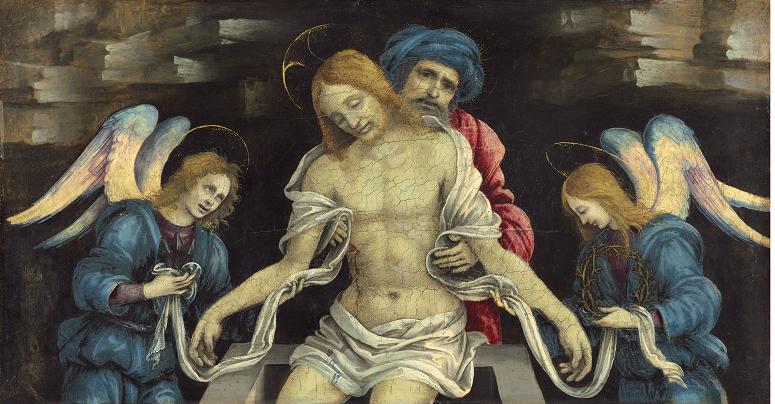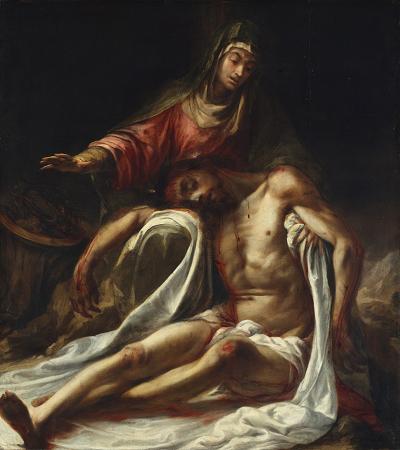Pieta. A pietā is a subject in Christian art depicting the Virgin Mary cradling the dead body of Jesus, most often found in sculpture. As such, it is a particular form of the Lamentation of Christ, a scene from the Passion of Christ found in cycles of the Life of Christ. When Christ and the Virgin are surrounded by other figures from the New Testament, the subject is strictly called a lamentation in English, although pietā is often used for this as well, and is the normal term in Italian. Pietā is one of the three common artistic representations of a sorrowful Virgin Mary, the other two being Mater Dolorosa and Stabat Mater. The other two representations are most commonly found in paintings, rather than sculpture, although combined forms exist. The pietā developed in Germany about 1300, reached Italy about 1400, and was especially popular in Central European Andachtsbilder. Many German and Polish 15th-century examples in wood greatly emphasise Christ's wounds. The Deposition of Christ and the Lamentation or Pietā form the 13th of the Stations of the Cross, as well as one of the Seven Sorrows of the Virgin. Although the pietā most often shows the Virgin Mary holding Jesus, there are other compositions, including those where God the Father participates in holding Jesus. In Spain the Virgin often holds up one or both hands, sometimes with Christ's body slumped to the floor. Main article: Pietā A famous example by Michelangelo was carved from a block of marble and is located in St. Peter's Basilica in the Vatican City. The body of Christ is different from most earlier pietā statues, which were usually smaller and in wood. The Virgin is also unusually youthful, and in repose, rather than the older, sorrowing Mary of most pietās. She is shown as youthful for two reasons; God is the source of all beauty and she is one of the closest to God, also the exterior is thought as the revelation of the interior. The Pietā with the Virgin Mary is also unique among Michelangelo's sculptures, because it was the only one he ever signed, upon hearing that visitors thought it had been sculpted by Cristoforo Solari, a competitor. His signature is carved as MICHAELA GELUS BONAROTUS FLORENTIN FACIEBA Michelangelo Buonarroti the Florentine did it. In a lesser known Michelangelo pietā, The Deposition, it is not the Virgin Mary who is holding Jesus' body, but rather Nicodemus, Mary Magdalene, and the Virgin Mary. There is some indication that the man in the hood is based on a self-portrait of the artist. The sculpture is housed in the Museo dell'Opera del Duomo in Florence and is also known as the Florentine Pietā. A generation later, the Spanish painter Luis de Morales painted a number of highly emotional pietās, with examples in the Louvre and Museo del Prado.
more...













